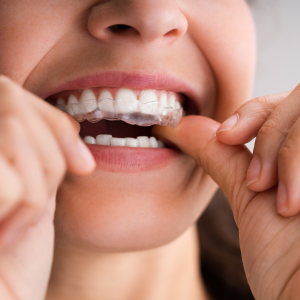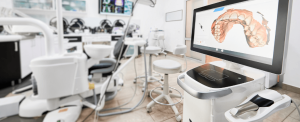Doncia is constantly evolving and dental aligners are no exception. In recent years we have seen significant advances in technology and materials used for its creation, being a highly effective product, becoming a highly attractive option for patients today.
Advances in dental aligners 2023-2024

Improved customization and accuracy
- 3D printing: 3D printing is increasingly used to create custom aligners that fit perfectly to each patient’s mouth. This allows a precise and efficient treatment, with less discomfort and an excellent final result.
- Intraoral scanning: intraoral scanners evolve by leaps and bounds every year. These advances continually allow specialists to design aligners with greater precision.
- Artificial intelligence (AI): the development of programs and algorithms allows you to create and analyze patient data, allowing more accurate diagnoses and personalized treatment.
Comfortable and biocompatible materials:
- New generation plastics: new plastics are being developed that are more flexible, comfortable and durable than traditional materials. This makes the aligners a pleasant product to use and also less proposed to break.
- Biomaterials: some orthodontists are using biomaterials, such as PLA (polylactic acid), which are more biocompatible and sustainable than traditional plastics.
Comfort and convenience:
- Remote monitoring: it is currently possible to track the progress of patients without having to go to the consultation so often. This can be especially useful for patients living in remote areas.
Currently, for dental professionals, the incorporation of dental aligners in their practice can represent a unique opportunity to expand their range of services and increase their patient base. Some of the benefits of offering dental aligners include:
- Patient Satisfaction: the dental aligners are comfortable to use and do not cause the discomfort associated with the metal brackets. This can lead to greater satisfaction on the part of consumers, which in turn can generate recommendations and positive references to other people, quickly expanding their preference.
- Greater discretion: many patients prefer to go almost unnoticed when it comes to using orthodontics, as demonstrated by a study published in the American Journal of Orthodontics and Dentofacial Orthopedics, where the main reason why patients choose aligners was the discreet appearance (96%). Traditional metal braces, on the other hand, were associated with a less attractive aesthetic, generating social discomfort.
- Additional Income Flow: the sale of dental aligners may represent an additional source of income for dental practice. In addition to the cost of the treatment itself, patients usually require follow-up and maintenance consultations, which can generate recurring income on a case-by-case basis.
- Competitive Differentiation: in an increasingly competitive market, offering innovative services such as dental aligners can help differentiate the practice from the competition. This can be especially relevant in areas where the demand for aesthetic treatments is increasing.



